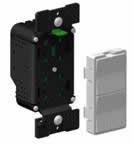GimpMaster
Member
I spent a great deal of time with the guys from AO on the phone last week (great guys by the way). I think I'm finally starting to understand how to run UPB, but I figured I would solidify my knowledge with an example from my home under construction and get your guy's feedback.
Attached below is an image of my main floor living room/kitchen/dinning area. I would like to have most of this space under home automation control using UPB switches. I would love to condense all the switch panels down to the minimal needed and use Scene buttons. From my NEW understanding now is that I only need one switch that controls the load to the light segments. These could probably all be installed on the wall that is shared with the Pantry (103). The other switch locations on the top fireplace wall or by the sliding door would no longer need to be three way or four way switches and are essentially just controllers that are plugged into the electrical system but do not carry a load.
Now for each load I would like to control I would need to either add a switch that carries the load (AO showed me a switch that can handle two loads) or I would have to need to get an inline relay that is hidden away.
Anyways, I'm looking for validation on my understanding or even suggestions on how you guys would handle this.
Thanks in advance.
Josh
[sharedmedia=gallery:images:558]
Attached below is an image of my main floor living room/kitchen/dinning area. I would like to have most of this space under home automation control using UPB switches. I would love to condense all the switch panels down to the minimal needed and use Scene buttons. From my NEW understanding now is that I only need one switch that controls the load to the light segments. These could probably all be installed on the wall that is shared with the Pantry (103). The other switch locations on the top fireplace wall or by the sliding door would no longer need to be three way or four way switches and are essentially just controllers that are plugged into the electrical system but do not carry a load.
Now for each load I would like to control I would need to either add a switch that carries the load (AO showed me a switch that can handle two loads) or I would have to need to get an inline relay that is hidden away.
Anyways, I'm looking for validation on my understanding or even suggestions on how you guys would handle this.
Thanks in advance.
Josh
[sharedmedia=gallery:images:558]


